Economy
In 1917, the overwhelmingly agrarian Russian Empire boasted a small but dynamic industrial sector encouraged since the 1890s by state-led investment. World War I pushed Russia's industries, farms, and markets to the breaking point. The war was followed by revolution, disorder and runaway inflation. Moreover, the demands of the Russian Civil War placed even greater pressure on the economy while centralized decision-making and the curbing of free market activity resulted in a near collapse the nation's financial sector in the early years of Soviet rule. [Text continues at bottom of page]

As basic goods became scarce, authorities requisitioned food directly from peasant producers. Depreciated currency caused a barter economy to flourish. This ad hoc approach (christened "War Communism") appealed to some radicals in the government who saw it as a precursor of their utopian ideal. However, the result was a catastrophic decline in output and economic levels fell to a fraction of their prewar totals.
Addressing the resulting peasant revolt and economic upheaval, Vladimir Lenin proclaimed the New Economic Policy, or NEP, the Soviet Union's first systematic economic program. The government controlled foreign trade, banking, transport, and heavy industry, leaving space for private trade, services, and small-scale manufacturing. Compulsory food requisitioning gave way to a tax levied on peasants' crops, leaving them to dispose the rest of their surplus in re-legalized markets. Initially paid in kind, the tax converted to a cash payment once the state issued a stable currency in 1924. Although the country remained relatively poor, the NEP improved economic indicators even as it had crisis hardwired into it: an imbalance between low prices for agricultural produce and high ones for manufactured goods. By 1928, Josef Stalin had defeated political rivals, ending debates about the pace of and mechanism for industrialization. Feeling surrounded by hostile capitalist powers, Stalin grew alarmed at the lack of capacity to manufacture tanks, planes, and other weaponry required for modern warfare. The First Five-Year Plan, initiated in 1928, envisioned breakneck industrialization, aided by imported technology. In addition to needing to feed a growing industrial labor force, the state sought to finance imports by exporting grain, along with oil, timber, and other commodities. Unhappy with market prices, peasants withheld their crops, an act Stalin and his followers deemed sabotage of their industrialization initiative. They terrorized the countryside and forced individual families into collective farms subject to state control. World prices fell as the world entered the Great Depression, causing leaders to try to meet their earnings targets by increasing exports even further.
Amplified by the authoritarianism inherited from the civil war period, Stalinist economics reinforced hierarchy and top-down control from Moscow, which imposed plans for investment and for output of thousands of individual products. Successive five-year plans prioritized heavy industry at the expense of agriculture and consumption. The state owned or controlled almost all enterprises, set virtually all prices, and exercised quasi-militarized workforce discipline. Imprisoned for crimes real or imagined, convicts labored in harsh, remote climates where free laborers refused to go. Even relatively free laborers faced harsh conditions, including rationing of food and consumer goods from 1929 to 1935 and again during and after World War II. Even during better times between 1935 and 1941, everyday necessities remained scarce. Pouring resources into heavy industry, the state curbed supplies. It also set artificially low prices for these goods, meaning that inflation manifested as scarcity rather than rising prices.
The Stalinist model proved resilient enough to get the Soviet Union through the war with Nazi Germany, postwar reconstruction, and the Cold War arms buildup. Although capable of some adaptation, it was unsustainable. When Stalin died in 1953, his successors quickly relaxed punitive laws on labor discipline and tackled excessive centralization. Previously, each of the dozens of ministries managed a vertically integrated chain of enterprises in a single industry, an arrangement motivating them to hoard resources and favor parochial interests over the common good. After a 1957 reform, management partially shifted from Moscow to regional economic councils, but they acted in similar ways. Moreover, this alienated a powerful constituency of Moscow--based bureaucrats, who opposed Premier Nikita Khrushchev's reforms and backed his fall from power in 1964. Reinforcing the powers of Moscow and the ministries, his successors considered measures to incentivize ministries and enterprises to produce in-demand goods and measure success not in gross output, but in sales and in profit. Potentially momentous, this program achieved little because the tide turned against reform in 1968, augmenting suspicion about the potential consequences of introducing extensive market-like mechanisms into management. The Soviet Union therefore lumbered along, continuing to favor heavy and defense industries. Prices reflected neither supply nor demand, making rational planning of production and investment actually impossible. The primary measure of success---quantitative production quotas---deterred taking risks to introduce new, more efficient products or processes. Supplies of food and consumer goods improved, but remained well short of abundant.
In 1985, Mikhail Gorbachev inherited an economy that functioned, but was in need of changes to address its many troubles. Innovations introduced by Gorbachev destabilized the old ways without establishing a workable alternative. As a result, the disruptions of economic innovation combined with the fragile domestic political situation and social ferment made holding the system together impossible. The federal structure of the Soviet Union facilitated its dissolution in late 1991, as political elites traded belief in Soviet-style socialism for an experiment in unbridled capitalism.
Suggested Readings and Resources
Paul Gregory, Political Economy of Stalinism: Evidence from the Soviet Archives (Cambridge University Press, 2003).
Alec Nove, An Economic History of the USSR, 3rd ed. (Penguin, 1993).
Seventeen Moments of Spring, "Economics" http://soviethistory.msu.edu/theme/economics/
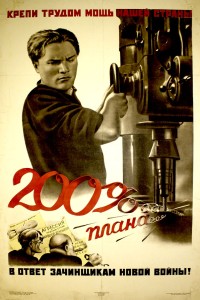
![PP 072: The fifth five-year plan of rebuilding and economic growth for the USSR 1946-1950. [Partial translation]](https://www.posterplakat.com/thumbs/the-collection/posters/pp-072/pp072-200x300.jpg)
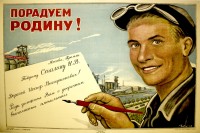
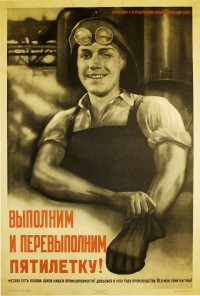
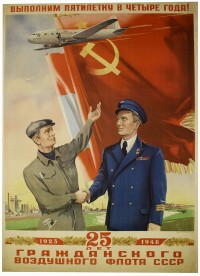
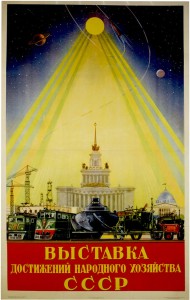
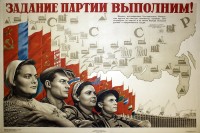
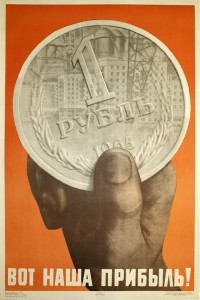
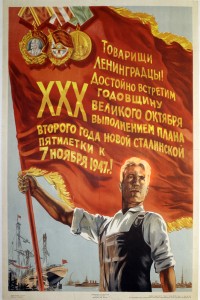
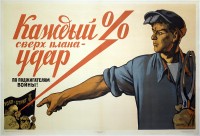
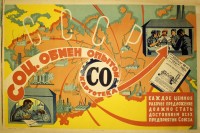
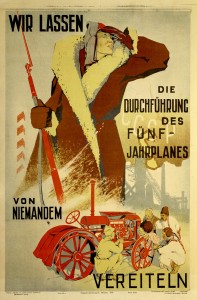
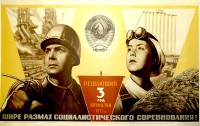
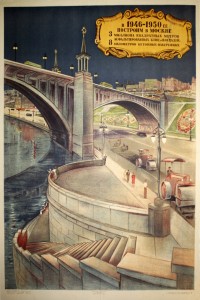
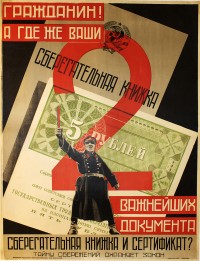
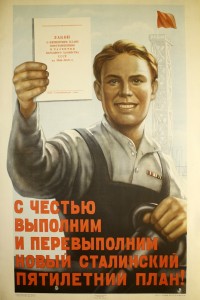
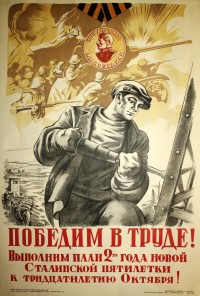
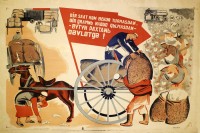
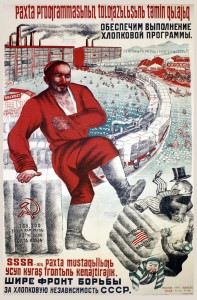
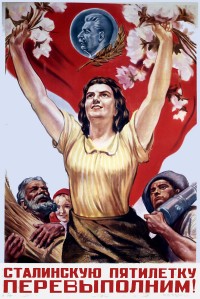
![PP 463: Capital Expenses For The Year 1932.
21,000,000,000 rubles
[Partial translation]](https://www.posterplakat.com/thumbs/the-collection/posters/pp-463/pp463-200x275.jpg)
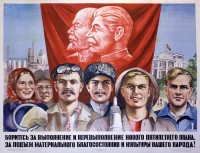
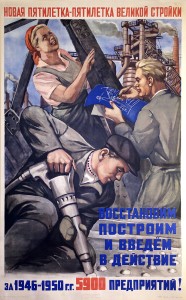
![PP 550: [Pending translation (Без Перевода)]](https://www.posterplakat.com/thumbs/the-collection/posters/pp-550/pp550-200x296.jpg)
![PP 561: Stalin's 6 Directives.
[Partial translation]](https://www.posterplakat.com/thumbs/the-collection/posters/pp-561/pp561-182x300.jpg)
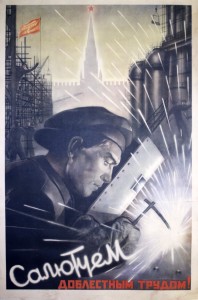
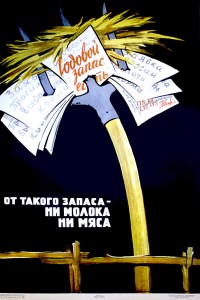
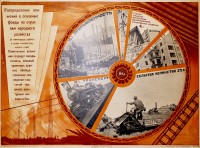
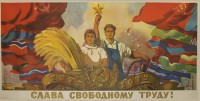
![PP 653: Results of the First Five-Year Plan.
[Partial translation]](https://www.posterplakat.com/thumbs/the-collection/posters/pp-653/pp653-200x267.jpg)
![PP 686: Those in the scientific, art, literature, engineering, technical, and academic fields, and to doctors, teachers and government employees! Support the continuing development of technology. Support the flowering of art and culture of the people! Be on the forefront of subscribers to the USSR Supreme People's Economic Recovery Loan [for] economic and cultural recovery!](https://www.posterplakat.com/thumbs/the-collection/posters/pp-686/pp686-200x300.jpg)
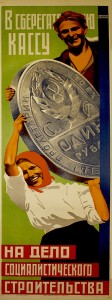
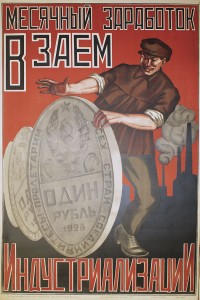
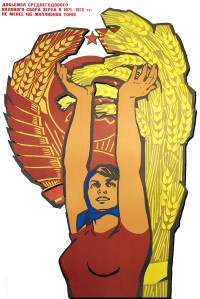
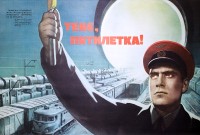
![PP 773: Carry your paper money to the Potrebilovka Cooperative.
And you will save money and will help us finance the purchase of merchandise.
[Partial translation]](https://www.posterplakat.com/thumbs/the-collection/posters/pp-773/pp-773-catalog-image-200x290.jpg)
![PP 775: Member of the Agricultural Credit Association!
Check for yourself:
Have you repaid your borrowings on time?
Have you paid your initial deposit in full?
[Partial translation]](https://www.posterplakat.com/thumbs/the-collection/posters/pp-775/pp-775-catalog-image-200x152.jpg)
![PP 787: What the republic has given as top priority to the starving Siberian region. [Partial translation]](https://www.posterplakat.com/thumbs/the-collection/posters/pp-787/pp-787-catalog-image-200x278.jpg)
![PP 801: Printers!
Let’s make the Third Year of the Five-Year Plan a Shock-Worker Year by Fighting to Fulfill the Promfinplan'.
January 1st [in Russian and Georgian].
Long Live the 2nd Day of the Shock-Worker.
Review of Fighters who Should Fulfill the Five-Year Plan in Four Years](https://www.posterplakat.com/thumbs/the-collection/posters/pp-801/pp-801-catalog-image-200x133.jpg)
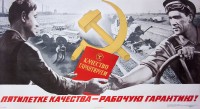
![PP 861: Lenin and the Peasantry.
“The industrious peasant is a central figure in our economic development.” – Lenin
[Partial translation]](https://www.posterplakat.com/thumbs/the-collection/posters/pp-861/pp-861-catalog-image-200x147.jpg)
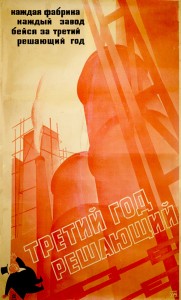
![PP 908: USSR Gosstrakh [State Insurance Company]
Have you insured your life with Gosstrakh?
[Partial translation]](https://www.posterplakat.com/thumbs/the-collection/posters/pp-908/pp-908-catalog-image-187x300.jpg)
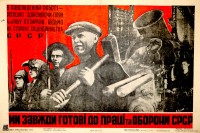
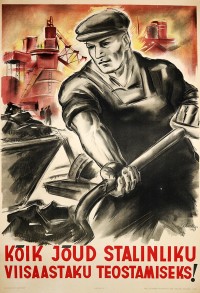
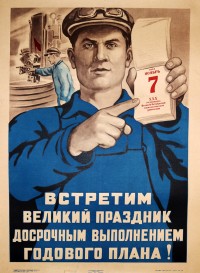
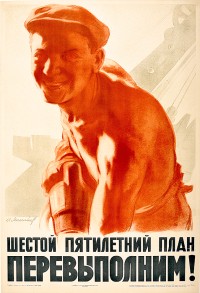
![PP 1136: All-Ukrainian Cooperative Bank.
Comrades–Cooperative Members! Workers and Peasants!
“A system of civilized cooperatives with public authority over an abundance of food products after the victory in the class [struggle] of the proletariat over the bourgeoisie – that is socialism.” – Lenin
[Partial translation]](https://www.posterplakat.com/thumbs/the-collection/posters/pp-1136/pp-1136-catalog-image-200x269.jpg)
![PP 1168: In May 1928, the first edition of the loan to strengthen the peasant economy will begin.
[Partial translation]](https://www.posterplakat.com/thumbs/the-collection/posters/pp-1168/pp-1168-catalog-image-200x147.jpg)
![PP 1169: Single Agricultural Tax [Partial translation]](https://www.posterplakat.com/thumbs/the-collection/posters/pp-1169/pp-1169-catalog-image-200x139.jpg)